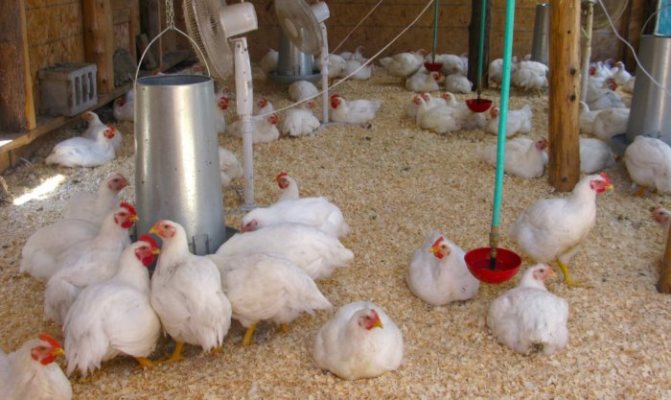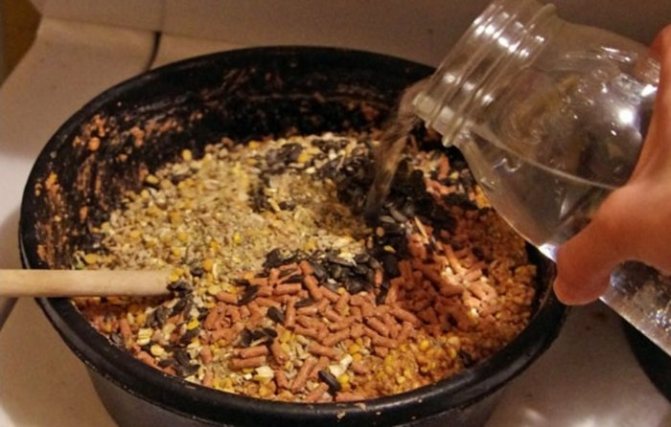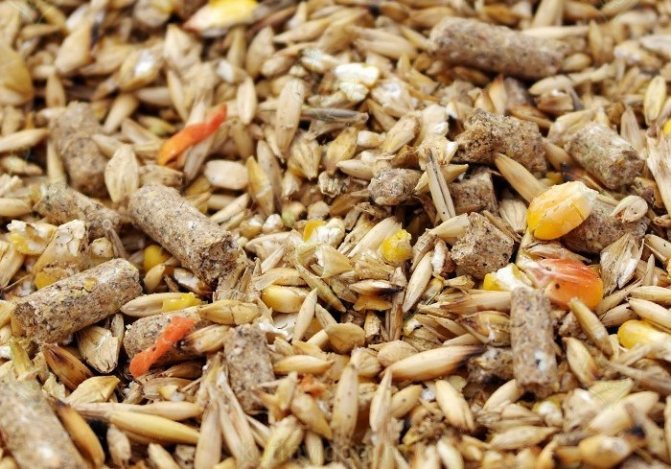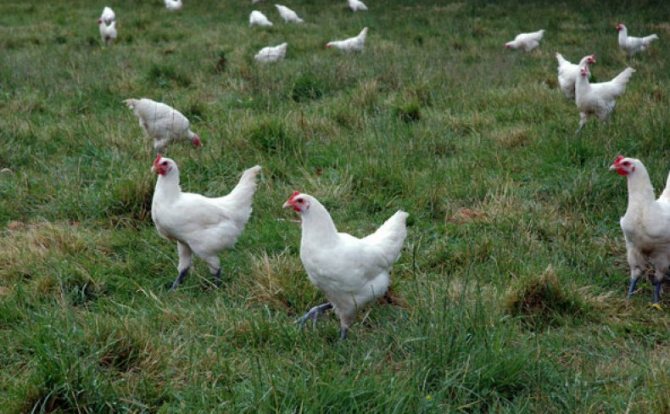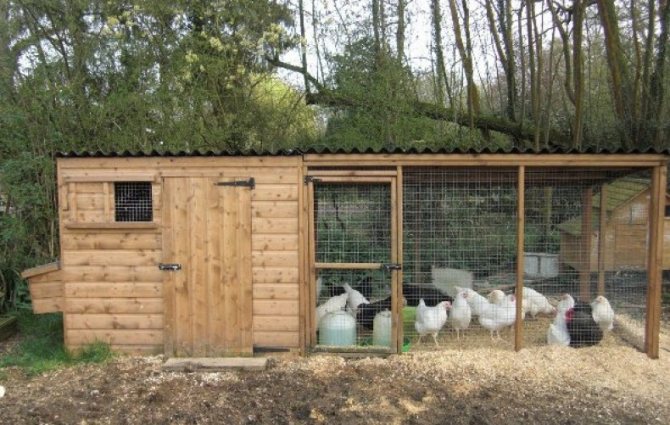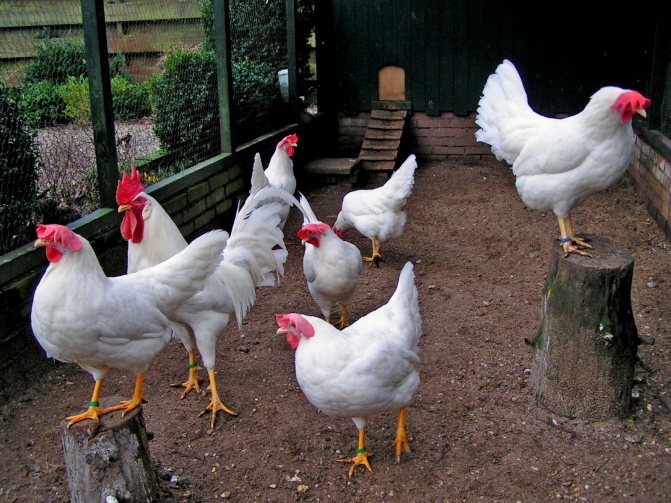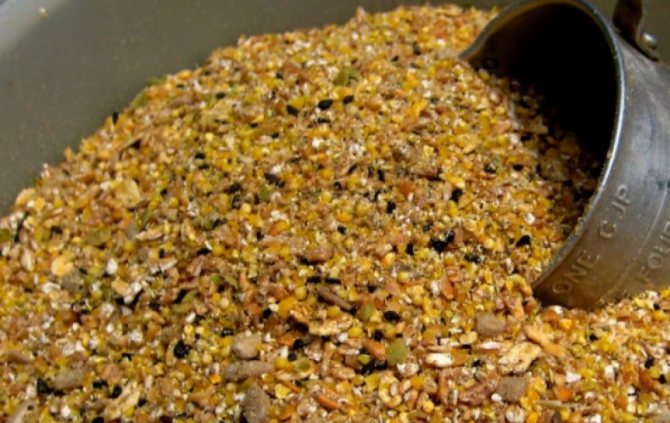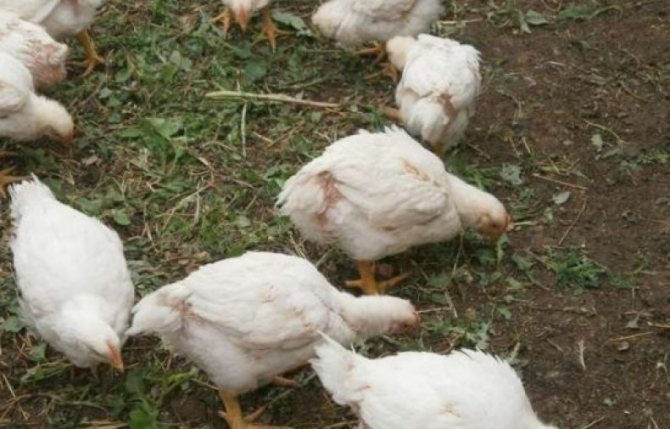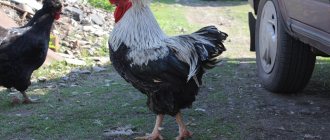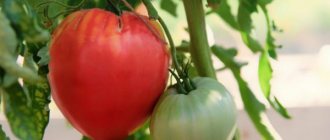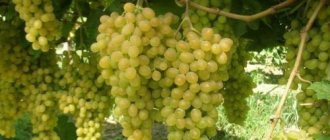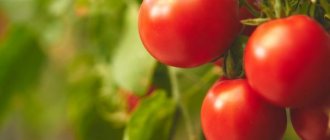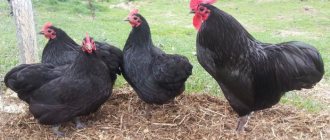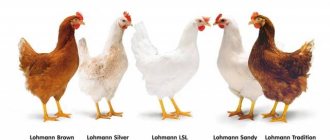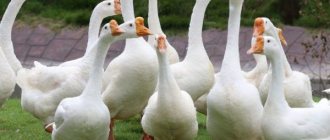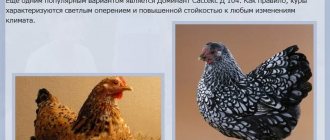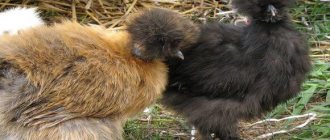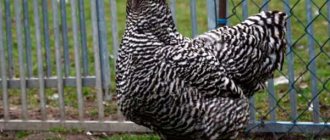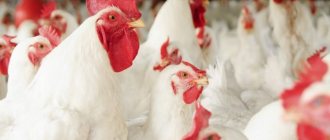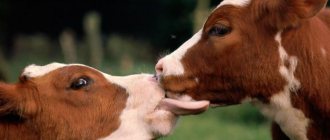Until 1965, on the territory of the USSR, exclusively Russian white chickens were used as egg-laying chickens. Their average productivity was almost 190 eggs per year, weighing 60 g. In breeding poultry farms, breeders managed to breed Russian white chickens with an egg production of 200 or more eggs per year.
Unfortunately, under the conditions of industrial use, this breed has become uncompetitive with foreign white Leghorns. According to rough estimates, Russian whites were inferior to Leghorns in productivity by 50 eggs per year, and in terms of the total weight of eggs - by 3 kg per year.
Due to low competitiveness, the number of this breed in 1990 decreased to 3 million individuals (in 1975 it was almost 30 million individuals). Now this breed has retained its former livestock in the territory of Turkmenistan, Azerbaijan and Uzbekistan.
Russian breeders continue their work on this breed, hoping to somewhat improve its egg production and endurance. It is assumed that in the future, Russian white chickens will be able to better compete with foreign counterparts.
Description of the breed Russian White
The Russian white breed of chickens is characterized by the following exterior features:
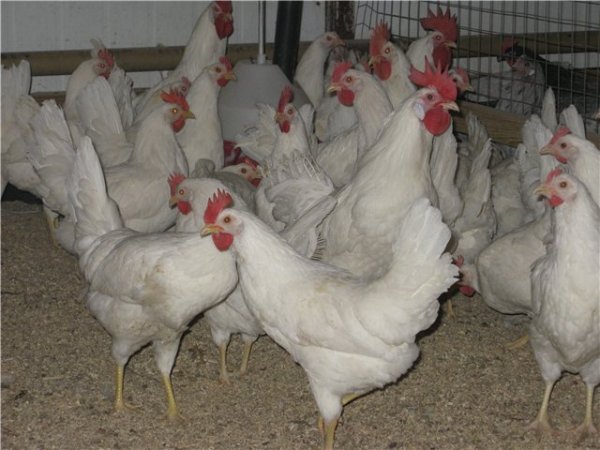
- The head is of medium size, well developed.
- Roosters have a large leaf-shaped comb with five teeth.
- The comb of the chickens hangs slightly to one side.
- Strong yellow beak.
- White earlobes.
- Thick neck with medium length.
- The chest is convex and wide.
- Elongated body and broad back.
- Bulky belly.
- Well-developed wings adhere well to the bird's body.
- Legs are yellow, no plumage.
- Well developed tail with moderate length.
All birds of the Russian White breed have the same color... Day-old chicks are completely covered with yellow down, which is replaced with white feathers as they mature. During the selection of Russian white chickens, any deviation from the standard is not allowed. Birds that look like Leghorns must be discarded.
Diseases of chickens
Chickens and chickens can suffer from many diseases. Infectious lesions are most common among the livestock. These include:
- pasteurellosis;
- colibacillosis;
- Newcastle disease;
- salmonellosis;
- tuberculosis.
| Name of the disease | Clinical manifestations | Treatment |
| Colibacillosis | Physical inactivity, fever, intense thirst. Loud wheezing may occur. | Biomycin 0.01 g / kg poultry weight per day. |
| Salmonellosis | Lethargy and inactivity, lacrimation. The chicken refuses to eat, but drinks a lot. Heavy breathing may be noticed. The cloaca is inflamed, the stool is liquid, frothy. In severe currents, birds limp and can fall on their side. | Insulation. Furazolidone 1 tablet in 3 liters of water for 21 days. |
| Pasteurellosis | The mortality rate is extremely high. Chickens are very thirsty, body temperature rises, lethargy and almost complete immobility appear. The feathers are ruffled, and the comb becomes bluish in color. Characterized by the presence of loose stools and massive discharge from the nose. | Isolation, Tetracycline in the form of a 1-3% aqueous solution. Dosage: 500 mg per day - 21 days. |
| Newcastle disease | Lethargy, shortness of breath, dislike for food. Characterized by the presence of mucus discharge from the beak, which smells extremely unpleasant.After a few days, the crest of the bird turns blue and it dies. | No medicine found. |
| Tuberculosis | It can affect any organs. The chicken is sluggish, it quickly loses body weight. The crest and earrings are pale or grayish. | It is incurable in chickens. After identifying diseased individuals, a thorough disinfection of the habitats of the remaining chickens and an examination for the presence of tuberculosis are needed. |
Among non-infectious pathologies, the following are common:
- Atony of goiter. The main reason is the use of low-quality feed for food. Only laying hens are ill, pathology does not occur in roosters. The bird's goiter gradually hardens and sags, death is possible as a result of airway obstruction.
- Gastroenteritis. The reason is similar - poor nutrition. If the chicken has a decreased appetite, loose stools, lethargy, this condition can be suspected. Unlike humans, it is simple to treat: you need to normalize food.
- Cloacite. The reason is poor quality food combined with hygiene violations. To eliminate the pathology, it is recommended to give the bird more vegetables, as well as rub the lesion with ointments with antibacterial components (for example, tetracycline).
- Avitaminosis. It develops with insufficient addition of vitamin supplements to the diet in the autumn-winter period. Initial manifestations can be fatigue and feather thinning. Treatment: increasing the normalized dose of vitamins and minerals by 20-30%.
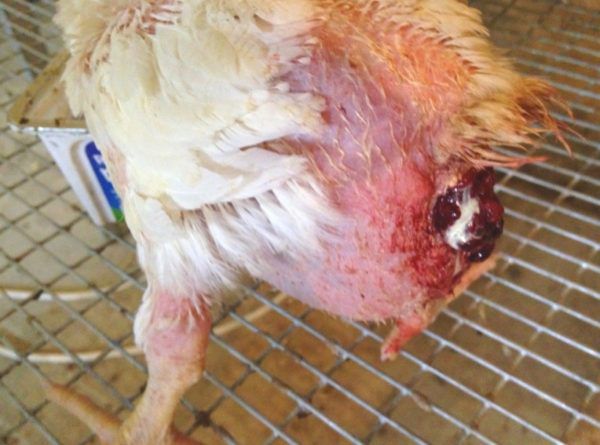

Chicken with cloacite
Video - Diseases of chickens: how to fight infections
Features of the
It is an egg-laying breed that is kept in poultry farms. purely for good egg production.
In addition, Russian white chickens were specially bred for resistance to microorganisms, neoplasms. That is why they are of interest to the entire biological industry involved in the manufacture of safe drugs.
This breed can be used on both large farms and small farms. It is well suited for novice bird breeders, as it does not require serious care and attention.
Chickens of this breed are resistant to all common diseases, so the level of safety for adult birds is approximately 91%, and for young birds - 96%.
Photo
Here in the photo is a young rooster, in his cage. A little scared of the camera ...


Here you can see a photo of Russian white chickens sitting quietly on a stick:


And this is a very young individual walking in the fresh air:
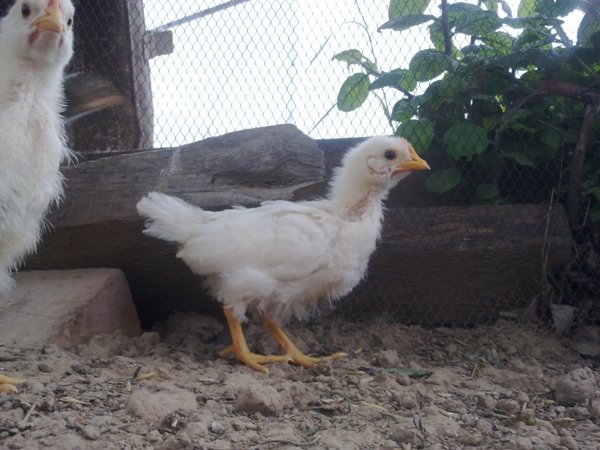

One chicken weighs only 43 grams:
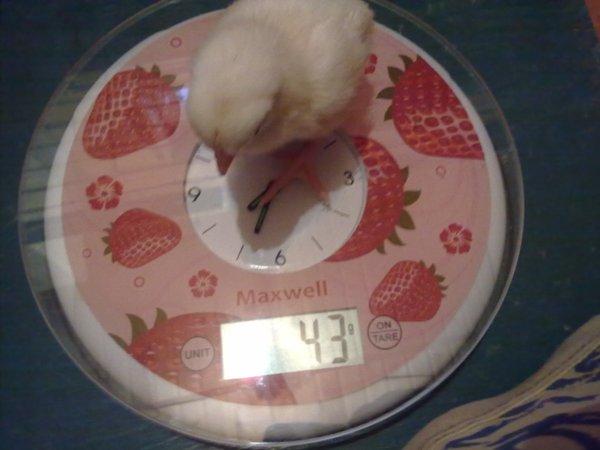

Recently hatched chicks:
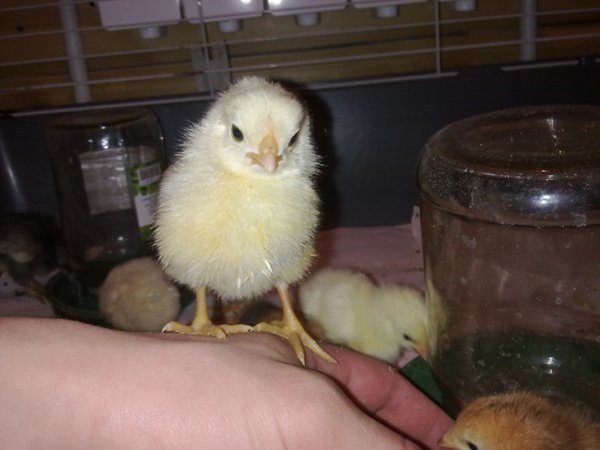

Nice photo of chickens climbing onto the container:
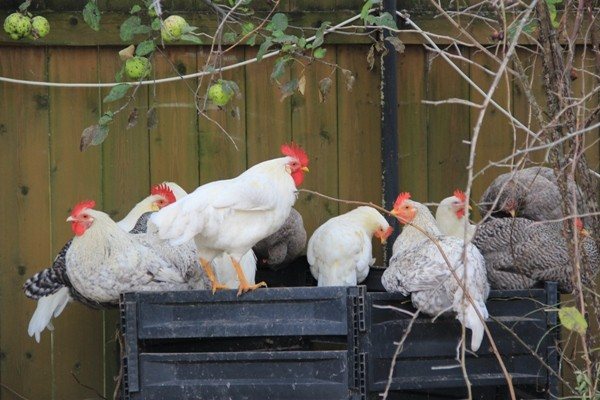

Well, this is the usual environment for Russian whites:


Maintenance and cultivation
There are several possible options for keeping Russian white chickens. Each of these methods has its own advantages and disadvantages, which in no case should be forgotten.
Birds of this breed can be kept on coarse litter... This option is ideal for owners of large areas. It consists in keeping chickens in a special room, the floor of which is covered with coarse bedding. Most of the time, Russian white chickens should be walking.
At the same time, the owner of the site can save on compound feed, as the birds begin to collect pasture in the form of seeds, green plants and insects. However, one must take into account the fact that the number of chickens should not be too large. Otherwise, the birds will trample the ground and eat all the insects.
The risk of developing any kind of infectious disease may also increase. The fact is that in a large area it is very difficult to keep track of all the chickens, so the farmer you need to devote more time to your birds.
Moreover, a particularly curious chicken can run outside the property, where it can easily become prey to a bird of prey or a neighbor's cat.
Common pumpkin is able to prevent many diseases when consumed regularly. Growing and caring for a pumpkin is not as difficult as it seems.
How sometimes you want to eat fried meat! Learn how to make a DIY brick barbecue by reading this article!
To prevent birds from being endangered while walking, you should fence off a small piece of land that is adjacent to the chicken coop. Poultry farmers call it "solarium".
The land on the plot must be firm, otherwise the farmer will experience difficulties during harvesting. Farmers should not make an earthen floor in a "solarium", otherwise it will turn into a dirty "mess" with a lot of microbes after rain.
Poultry breeders who do not have a sufficient area of land to keep Russian white chickens on coarse bedding should equip the keeping of chickens in cage batteries.
This housing option allows the farmer to save space by placing chickens in a small area. In addition, this method simplifies the care of chickens, since the owner can make a round every day, checking the condition of the layers.
The floor in the coop will almost always remain clean, as the birds will spend all their time in their cages. At the same time, they will consume less grain feed, since they do not waste energy while walking.
Unfortunately, the cellular version of the content has its drawbacks... Due to the lack of walking, the farmer must regulate the microclimate in the chicken coop.
Temperature and humidity that are too low or too high can negatively affect the health of the entire poultry population. The relative humidity in the room where Russian white chickens live should not exceed 70%
The air temperature in both cold and warm seasons should not go beyond -2 to +27 degrees. With a significant drop in temperature in Russian white chickens, the comb and catkins begin to freeze. The number of laid eggs is gradually decreasing, but the birds continue to consume compound feed, and in increased volumes.
During the heat, Russian white chickens begin to gradually refuse feed, which in the future will negatively affect the number of eggs laid. Due to exhaustion and lack of water, chickens stop rushing, causing inconvenience to the owner of the farm.
Chick feeding
At an early stage, Russian white chickens are fed in the same way as broilers. All young animals are transferred to two- or three-phase feeding. As the chickens grow, the protein level in the feed is reduced as the adult chickens eat more feed.
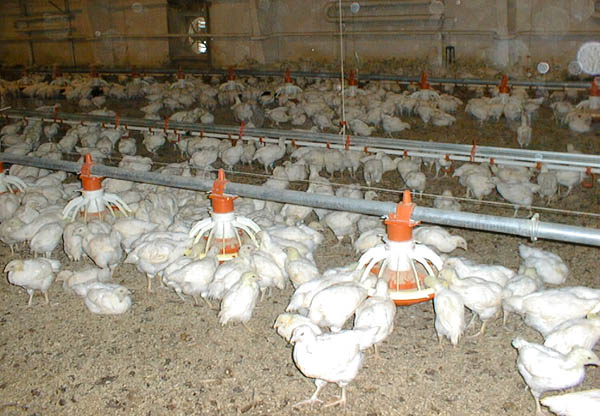

Until the age of 8 weeks, Russian white chickens are not limited in food. After that, the amount of compound feed is reduced by 20%, but at the same time it is necessary to make sure that all chickens have the same access to the feeders.
It is better for small chickens not to give large feed in granules, but its crumbs. Chicks take longer to absorb this feed. In addition, the likelihood of pecking among young chickens decreases.
From the 21st week, young chickens should eat like adults. The diet of adult birds is characterized by a high content of calcium salts. They promote the formation of eggs with a thicker shell, which prevents its deformation.
Young birds should also be well prepared for the first clutch of eggs. For this, an increased amount of protein is added to the feed of Russian white chickens. With its help, the reproductive system and the egg follicle itself are formed faster in them.
Nutrition for adult layers
Adult chickens of the Russian White breed need to be fed with full-fledged compound feed twice a day. In this case, in no case should the feeder be filled to the top, otherwise the chickens will scatter all the feed.It is sufficient to fill the trough only 2/3 full.
When feeding birds with wet feed, always reduce the number of portions per serving.... Chickens should consume all the feed for half an hour, because it quickly turns sour and the amount of biologically active substances in it decreases.
After eating the feed, the bird feeders must be washed, otherwise they will become a favorable environment for the development of pathogens.
Beginning farmers should be aware that from the moment of first laying until 48 weeks of age, the number of eggs laid by a single hen grows rapidly. Because of this, the chicken should receive a larger amount of feed. Then there is a decline in egg production.
It reaches its minimum at the 48th week of the bird's life. At the same moment, the Russian white chicken stops gaining weight, and the farmer can reduce the amount of compound feed.
On average, 120 g of dry feed should be spent per hen per day. For a year, this figure is 44 kg. If green fodder is included in the diet, the dose should be increased to 170 g. Thus, grain fodder is saved, and the overall vitality and productivity of chickens increases due to the nutrients contained in juicy fodder.
Chicken feed
Poultry feed should contain an optimal ratio of proteins, fats and carbohydrates, as well as vitamins and minerals.
Proteins are the main building blocks for the growth and development of livestock. They provide high fertility. Most of the proteins are found in bone meal and legumes. Fats are energy for laying hens, they are abundant in corn and oats. For the adequate functioning of internal organs and metabolic processes, carbohydrates are needed, which are most of all in whole grains.
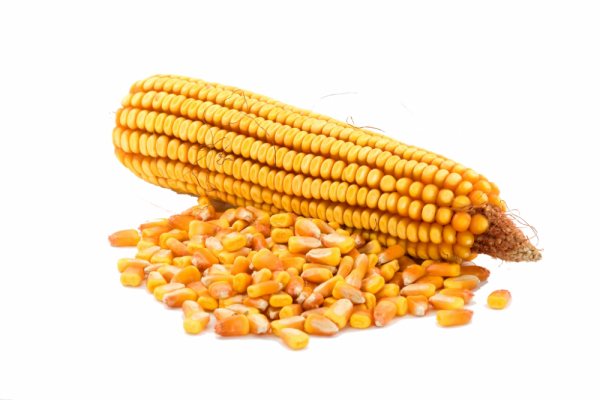

Corn is one of the healthiest chicken feed
Of the vitamins, the most valuable are A, B and D. Individual minerals are obtained from eggshells, chalk and wood ash.
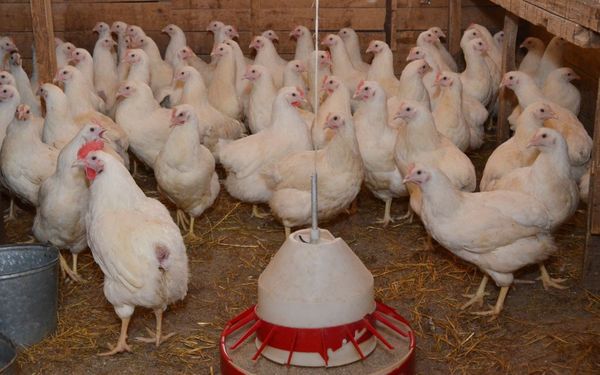

Bird Feeder Option
There are 2 main feeding methods:
- Purchase of finished compound feed. They are expensive but contain a balanced amount of all the essential ingredients.
- Self-preparation. The main advantage of this method is the low cost of food, however, preparation requires considerable time and some experience.
The optimal ratio of the diet is as follows:
| Ingredient name | Weight in grams |
| Grains | 50 |
| Chopped bone meal | 2 |
| Food (necessarily juicy) | 30 |
| Minerals and vitamins | 15 |
| Protein feed or mash | 10 |
Thus, each hen should eat 130-140 grams of food per day, which is almost 42 kilograms per year. Feed should be 3-4 times a day. The morning ration should be rich in whole grains, the daytime diet should be rich in minerals and vitamin supplements, and the evening diet should be rich in juicy food.
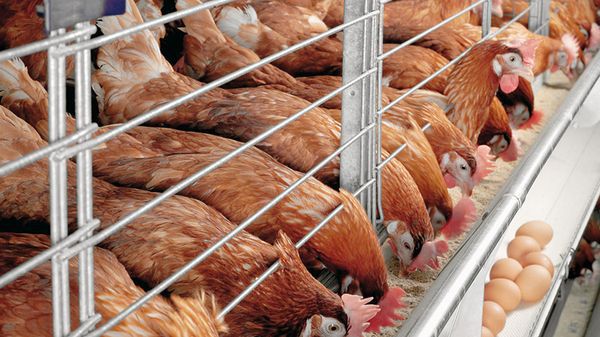

In poultry farms, chickens are fed at the same time
To improve digestion processes, a small amount of pebbles, sand, and crushed shells should be added to food. Otherwise, the feed may be poorly absorbed.
Characteristics
The egg production of Russian white chickens is 200 eggs in the first year of productivity.
On average, the mass of an egg, the shell of which has a white color, is 56 g. However, there are specially bred lines of chickens that can carry up to 244 eggs per year.
Record-breaking individuals can carry up to 300 or more eggs, but this is more the exception than the rule for the breed. Chickens begin to lay eggs from the age of five months, so the owner of a poultry farm with Russian white chickens can count on quick benefits.
Due to the fact that this breed of chickens was bred specifically to increase the number of eggs laid, its meat productivity suffered significantly. The live weight of chickens is only 1.8 kg, and of males - 2 - 2.5 kg.
Cornish
A hardy breed of chicken bred by UK breeders for meat production.Birds quickly adapt to any weather conditions and have an impeccable hatching instinct.
Productivity - up to 160 eggs a year, weighing 50-60 grams, with a brown shell.
The weight of the chicken is about 3.5 kilograms, the rooster is up to 4.4 kilograms.
External data:
- crest - pod-shaped;
- earlobes are red;
- the head and chest are wide;
- body - muscular, dense;
- tail - not long, drooping;
- plumage - white, on the limbs - absent.
You will find more fascinating information on the topic in the article "About gherkin chickens: what is it?".
Where can you buy in Russia?
- Now the pedigree breeding of Russian white chickens is carried out by specialists from Maryinskaya poultry farm, which is located in the Stavropol Territory. You can contact the specialists from this poultry farm by phone, +7 (879) 383-02-86.
- There is a poultry farm in Essentuki "Mashuk". She is engaged in breeding different breeds of chickens, including Russian whites. You can call the farm by phone, +7 (879) 345-49-62.
- Breeding of the Russian white breed of chickens is carried out by JSCAdler poultry farm". It is located in the city of Sochi. You can contact us about the purchase of eggs and adult birds by phone.
Chickens of noble birth - Sussex. How this breed was bred and what qualities it possesses is described in our article.
At the address you can find out how to properly plant and care for Astilba.
Analogs
Chickens of the Leghorn breed are somewhat similar to Russian whites. They are characterized by even greater egg production. Layers can start laying eggs from the 125th day of life. Thus, the annual productivity of eggs is 300 pieces per year. This is quite a lot, so breeding this breed can be a profitable business. However, novice farmers need to take into account the fact that these chickens have a lively and energetic character.
They prefer to walk for a long time around the yard, rummage in the ground and sometimes take off. Because of this, before buying this breed, you need to think about whether there is enough space for walking the birds.
Leghorns are well accustomed to any conditions of detention. In addition, they have good immunity, which makes it unnecessary to worry about vaccines. They are suitable for keeping on a farm or in a summer cottage.
Farmers reviews
Russian whites have earned excellent reviews from poultry farmers:
- Chicks are more viable, more resistant to external conditions, and are distinguished by good health;
- Layers consume less feed than other meat and egg hens and feed better;
- A very tasty, beautiful, snow-white egg, which is in demand among buyers;
- When crossed with breeds: Yurlovskaya vociferous, Kuchinskaya, Velzumer, Livenskoy calico gives very productive crosses.
As the only disadvantage of the breed, farmers note fearfulness. Nevertheless, according to their reviews, chickens get used to the owner and a certain daily routine, and become calmer.
The Russian White undoubtedly deserves a place in the courtyard for her endurance and productive qualities. In addition, these chickens are very smart in their snow-white clothes and will delight you with their appearance, along with a delicious egg.

